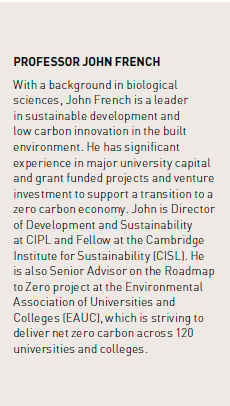As the property industry comes to embrace the UK’s net zero carbon commitments, John French, Director of Sustainability at Cambridge Innovation Parks Ltd (CIPL) talks to LSH’s Head of Sustainability, Frankie Bryon, about his work to drive innovation and challenge convention in commercial construction.
Download the full Thames Valley and South East Office Market Report 2021
The pandemic seems to have galvanised the property industry with regard to the sustainability agenda. Why do you think this is?
Yes, that certainly seems so. I think with any traumatic experience, it is an opportunity to recover in a better way. The motto of ‘build back better’ could not be more apt for the property sector; there appears to have been tangible shift in the mindset of investors and corporate occupiers to divest themselves of high- carbon assets and embrace the sustainability agenda in the wake of the pandemic. The key now is to channel this more positive mindset into action and ultimately, value.
With the built-environment accounting for 40% of UK carbon emissions, how much of a challenge is the property industry facing to meet government’s net zero target by 2050?
From a purely operational perspective, I have every confidence that moves towards decarbonising the UK energy grid will drive zero carbon, and well in advance of 2050. The growth of renewable power supply, both on and off site, alongside upgrades to the UK’s nuclear energy infrastructure should see to that, while the increased deployment of smart tech within office buildings will drive greater efficiency.
The central challenge is driving down carbon emissions across the building’s entire life-cycle. We are not going to get to zero-carbon by 2050 without a step change in low-carbon construction by the private sector - up to half of a building’s emissions derive from its construction and eventual demolition. Carbon offsetting is too easily seen as the get around to this problem, but this is not scalable to the extent that’s required.
It is in this area of low carbon construction and design that we are taking great strides in driving innovation and seeking to engender change in the industry.
You’re said to be behind the UK’s greenest ever building, reflected in over 30 awards and accolades including from the likes of RIBA, RICS and the BCO. What key attributes elevated the project to achieve this recognition?
Yes, in 2015, after seven years of careful planning, the University of East Anglia (UEA) opened the Enterprise Centre at Norwich Research Park. As well as being an attractive space for its occupants, it is an exemplar in low-carbon development and the UK’s first building to receive both BREEAM Outstanding accreditation at the master-planning, design and fit-out phases and Passivhaus certification for its use of zero-carbon architecture.
This building has a whole host of attributes that contribute to its low carbon footprint, although chief among these is that 70% of the materials comprise bio-based materials. Its frame is made largely of wood sourced from the nearby Thetford Forest and its walls include hanging strips of thatch, massively driving down its embodied carbon when compared with conventional commercial buildings involving steel and concrete.
Developers may be raising an eyebrow at talk of timber-framed offices. What do you say to the doubters?
If we are going to get serious about net zero, the use of timber has a massive role to play. Contrary to popular belief, timber-framed buildings can be built to scale using modern methods of construction and can be built to stand the test of time. All of our thinking around net zero assumes a minimum life-span of 100 years, and this is perfectly achievable if the wood is appropriately sourced and treated.
Challenging convention is admittedly a huge challenge, and this is what we are striving for. It is imperative that the bio-based supply chain is stimulated to respond in a way that is affordable, traceable and sustainable. The UK is actually blessed with potentially huge sources of timber, not only by luck in Thetford but in the other parts of the UK, particularly so Scotland. We recently launched a Timber Challenge with the BRE and 3PM, challenging construction companies and contractors to innovate in the production and provision of off-site timber construction.
What about your current projects? Can you tell us a little bit about what’s in the pipeline at the Waterbeach site?
In my current role at Cambridge Innovation Parks, we’ve been working on two low carbon buildings to the North of the Waterbeach site, planned for delivery in 2021 and 2022 respectively. The first, of 9,000 sq ft, will have a hybrid steel-and-timber structure, while the second building, of 40,000 sq ft, will involve modularised sawn-timber. Crucially, important lessons have been learned from the UEA project. Significant innovation has been necessary to deliver the wide spans and airtight outer layer, while complexity of energy flow is pushing engineers to their creative best.
There is more to come as well. At the West of the Cambridge site, we have prepared a masterplan which will make use of sustainable energy and infrastructure solutions. We are looking to include autonomous off-grid facilities too, involving PV and battery storage.

While these new-build projects are at the cutting edge of sustainability aspirations, what are your thoughts around about the renovation of existing buildings?
Eighty percent of UK buildings that will exist in 2050 have already been built. Therefore, sustainable retrofitting of existing stock will be absolutely crucial to meet climate change targets, and ensure buildings are fit for purpose in the future. While building new may be easier, we have to do better with what we have already got.
One Regent Street, Cambridge is one such project which endeavours to maximise sustainability gains within an existing structure. This is the world’s first sustainable office retrofit and entails the conversion of a 1930s built telephone exchange into the new headquarters for The University of Cambridge Institute for Sustainability Leadership (CISL).
What sort of measures are being taken with this project, and how does it differ from a new build?
We describe One Regent Street as a ‘deep green retrofit’. It is projected to result in an 80 per cent saving in whole life carbon emissions compared with a standard office refurbishment. As a world first, The Entopia Building aims to achieve multiple certifications, including BREEAM (Outstanding), the Passivhaus ‘Enerphit’ standard (designed specifically at refurbishments) and Well (Gold) certification.
One Regent Street embraces the Circular Economy approach and has incorporated a range of re-used items including steel girders for the roof terrace frame that supports the solar panels, reused galvanised raised floor throughout the building and the central core of the electrical supply is being tested and reused rather than being replaced. Light fittings were sourced by ISG from another building which were unused and destined for landfill.

Viability is often cited as the ultimate barrier to progress. What is your perspective through your wealth of experience?
Build costs for highly sustainable office buildings are deemed to be higher than conventional, but it’s a complex issue that our work is helping to address. Higher costs partly reflect the need for progress in the low carbon supply chain and, over time, we can expect greater efficiencies and economies of scale to bear down on costs.
Another key factor is a lack of familiarity with highly sustainable projects. Often, a contractors’ high cost estimate better reflects the ‘unknown’ or perceived risk in such projects, rather than the actual input costs themselves.
But, if you can get the right team in place, costs can be managed into commercially viable projects. At the Waterbeach site, for example, the build cost equates to a pretty reasonable £240 per sq ft, only a 10-15% or so premium over the conventional steel and concrete approach. Remember too that these are great spaces in their own right. These are inspirational working environments and they convey messages about commitment to sustainability, so we might reasonably expect occupiers to pay a higher rent for the privilege and benefit from lower running costs in the long run.


Download the full Thames Valley and South East Office Market Report 2021
REGISTER FOR UPDATES
Get the latest insight, event invites and commercial properties by email







